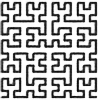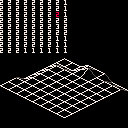One of the games I used to play the most was populous.
While some of my friends could play it with beautiful graphics on their amiga or atari ST :
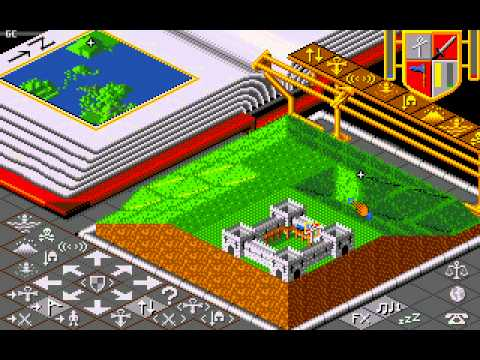
I was playing on a slow TO-16 PC compatible with CGA graphics and a monochrome green screen. You can't even find an online picture of a setting that bad for this game, the closest I could find online was color CGA that is actually almost as bad looking as the green version.
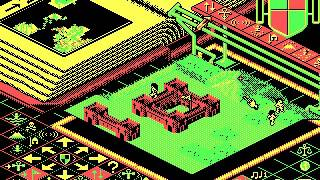
Despite the visuals, I was hooked and somehow managed to finish the game (level 400 something), using every possible trick available. (save scumming so the "random" swamps would always spawn under the enemy's knights feet, abusing the bad AI when possible (enemy flood that insta-kill every single enemy unit was the most memorable), using a bug that allowed to raise the terrain to level 1 on levels where it was disabled...).
Despite all that, after level 400, the building speed of the computer was just insane : he would add a block every frame (around 4 times per second on my crappy PC), making enemy progressing absolutely overwhelming.
Given the difficulty of fast and precise clicking (even after removing the dust on the rollers of the mouse), I stood no chance playing the same strategy, so I tried things and found a magic combo : 5 times raising terrain, 5 times lowering, 3 times raising and one time lowering.
With practice, in 14 frames, I could flatted a 6 by 6 square of land lo level 2, where the computer would use 49 frames to flatten the same surface to level 1, one square corner at a time(for way less mana though).
I could never understand at the time why the game would have such an obscure build shortcut.
There also was something both magical and slightly disturbing about the game :
The graphics felt somehow slightly wrong, even on the beautiful amiga/atari versions, yet impossibly easy to read.
In the 2nd screenshot, the castle is a very classic looking isometric view, reminiscent of all the classic of the genre, like marble madness or head over heels for example. But contrary to those games, the slopes are much less "pixel clean", but you have no problem reading the height of the elements, and somehow you can always see everything, regardless of the terrain.
Because I couldn't figure out why that was the case, I tried to re-make the terrain logic in pico-8.
1st few tries had the classic isometric look, but the back sides of pyramids was hidden, so I reduced the pixel height between levels and it became more readable, but some big mountain peeks or holes would occupy the same place onscreen as other elements, resulting in a big mess. Still, I was able to display actual terrain copied from screenshots, and that's how I figured out the trick : the game does not allow two touching intersection points (orthogonal or diagonal) to have a difference of height of more than one. If you try, the modification is processed, but then the game also moves the adjacent points that are too far towards the moved point. This can have a cascading effect, and that's where the magic 5 up 5 down 3 up 1 down comes from. It's absolutely not a hidden cheat, but just a consequence of the constrains chosen for the graphics to stay legible at all times and not require any hidden element logic.
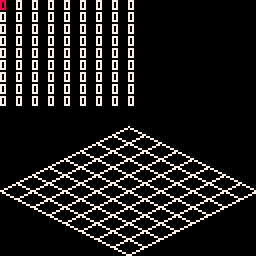
Finally, to view that all terrain stays within its pixel rhombus regardless of terrain, here are the two extremes :


Oh man, my friend had an Amiga and Populous was just mind-blowing. The graphics were amazing for the time, but the audio on the Amiga was even more incredible somehow. Populous was probably the most immersive game I played back then.
This is a cool deep dive, thanks for sharing!

I loved Populous (and Populous II, which tbh I played more). I remember being able to apply mods to it which blew my mind at the time.
I noticed the same terrain limitation when I played it although I only remember exploiting it a bit. I later had a go at implementing my own version in STOS Basic (anyone remember that?). I didn't get very far, but a PICO-8 attempt is in my mental dev wishlist... maybe one day.

I started my own version of Populous about 6 months ago. Loved the game so thought Id take up the challenge too. As you can see I didn't get very far.
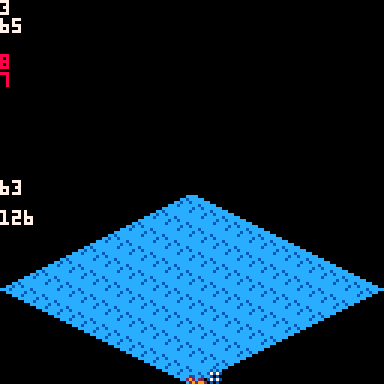
Also showed it to a friend who's also friends with one of the original developers. Showed it to him and they were impressed with the size of it and looked forward to it being complete, and also offered help with it. Sadly, never went any further :(
Good look in yours though, in whatever direction it goes next.

My friend, I love this project. I've always been enchanted by Bullfrog's games. Even attempted to make my own Populous (My coding skills are definitely not proficient enough currently, though) I basically just had some graphics drawn, mainly people drawn and animated. And some pset() commands on an array with different heights from information from a table.
Very intriguing concept for Pico-8. I hope your project goes well. :)

@2bitchuck , amiga sound was the best among 16bit computers of the era. I don't remember what populous sounded like, but Xenon 2 on amiga sounded awesome. Hadn't been that impressed with computer sound since Commando on C64. In the mean time, the PC speaker was just inferior. Turning music off was just the 1st thing to do after launching populous.
@drakeblue, populous is an ambitious project. Pico-8 has the memory to handle it, (it could run on computers with 512KO of ram), @Minion has a demo that shows PICO-8 resolution is sufficient, if a bit cramped. There's no chance to make it withing the token limit with normal programming, but multi-cart and parens-8 could work, or maybe programming a game input and display program, a populous related bytcode interpreter, and make the game logic as bytecode ?
I could work with drakebue and/or Minion on it starting january if you are interested.
@Minion : I'd have so many question for the authors.
Examples :
-
What was the "merge" move command supposed to achieve ? You'd think it would help in cold maps as the life drain is proportionnal to the number of guys walking outside, be the resul was more malking in the cold to try to meet instead of settling and staying safe inside, plus guy sometines would circle each othe in pairs until one of them died of the cold... I don't think I've ever managed to gain anything from trying it.
-
ON PC, clicking the very lowest point of the game rhombus would raise the terrain level from water to L1 even on game levels where building was disabled. Having a knight with sword and low health was quick win against nearly unarmed enemy. Was that intended ? Why ?
-
One of the monsters left a vertical trail of rocks. The AI never cleared it, so you could stay safe if you fully owned one of the sides and didn't clear the rocks. Any reason ?
-
When settling on a small spot, the leader loses his sword and need to merge with someone who has one or build a castle to get one back. Was that a game balance related choice ?
-
Mana bar is some kind of logarithmic scale, and the amount you will lose when a building gets burned or captured is also unclear. The one positive thing I liked about the system is the fact that the arrow reaches the symbol when you have enough for the spell. Was the game look deemed more important than readability of the stats ? (I do admit that the icons only visuals of the amiga still look great today)
- When trying the passwords of the booklet as level codes, you are sent to levels in the 800 something range. Those where about as hard as the last 400 something, and winning one would give the same ending as when winning the game. Were those levels supposed to be beatable at all, trolling, or an accident and not supposed to be playable ? Or maybe the computer's click per second was supposed to be even more but the computer was capped at once per frame and I was saved by the lag ?
SO many questions...

@RealShadowCaster anything I tried would be very much an approximation and I’m unlikely to get time for it very soon although I’d be interested to watch the progress of any project in this direction. Besides I clearly don’t remember the game anything like as well as others like yourself!
[Please log in to post a comment]





